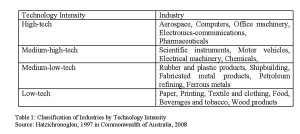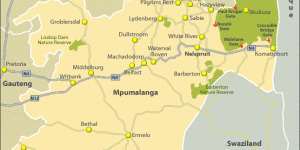IIDE Proceedings 2011 ~ Vol.I ~ Innovation Technology And The Challenges Of Low- And Medium-Tech SMEs: The Case Of Forest Products SMEs
No comments yetIntroduction
Low- and medium-tech (LMT) small and medium enterprises (SMEs) can be described as low research and development (R & D) performers. In this sector, innovation tends to occur but not on the basis of R & D results. By contrast, innovation in the sector is driven mainly by incremental product change rather than by the application or commercialisation of R & D. Nonetheless, technological upgrading in low- and medium-tech SMEs remains important as such firms can become competitive in the long run and therefore become a potential basis for further economic development. More significant are the large proportions of employment opportunities that are derived from the sector. Typically, the LMT sector deserves particular attention from both researchers and policy makers.
Indeed, the low- and medium-tech SME economy has the potential to stimulate endogenous growth through innovation. Policy attention should therefore focus on supporting and fostering innovation in the sector in order to ensure the greater probability of the survival of the enterprises, with employment opportunities as a positive consequence. More specifically, innovation policy remains central to the success of the LMT economy as this will increase the innovation capacities of LMT enterprises. The objective in this chapter is to explore the development challenges of low- and medium-tech SMEs. The chapter as a whole is structured into four sections of material. The first section introduces the national system of innovation and provides the conceptual framework of the chapter. The second section describes the low- and medium-tech SMEs. The third strand of material focuses on forest-products and is aimed at enhancing our analysis of the LMT sector. The fourth section focuses on the technological challenges of experienced by the low- and medium-tech SME sector.
The National System of Innovation
This particular section introduces the national system of innovation as a conceptual framework in this chapter. The main reason for focusing on the national system of innovation has to do with the fact that most public policies influencing innovation processes or the economy as a whole are still designed and implemented at the national level. The importance of the national system of innovation has partly to do with the fact that such a focus captures the importance of the policy aspects of innovation. It also enables us to identify the boundaries of the system of innovation spatially, sectorally, and in terms of activities (Edquist, 2005). Typically, a sectoral innovation system has to do with a group of firms active in developing and making the sector’s products and generating and utilising the sector’s technologies. A stronger focus on activities increases our knowledge and capacity for explaining the processes of innovation. This may be through asking certain relevant questions, which include which activities of which organisations are important for the development, diffusion or use of specific innovations (Edquist, 2005). The section draws heavily on the works of Fagerberg, Mowery and Nelson (2005).
According to Edquist (2005), a “national system of innovation” refers to the network of institutions in the public and private sectors whose activities and interactions initiate, import and diffuse new technologies. The structure of production and the institutional set-up jointly define the system of innovation. The national innovation systems approach emphasises the importance of strong linkages among these various institutions in improving national innovative and competitive performance (Mowery and Sampat, 2005). Increased inter-institutional collaboration is a characteristic of modern innovation systems. It is implicit in this definition that firms seldom innovate in isolation. Interaction with customers, suppliers, competitors and various other private and public organisations is very important, and a systems perspective is useful in understanding and analysing such interactions (Edquist, 2005).
The main components of systems of innovation are organisations and institutions. These organisations and institutions form the components of systems which are critical in the creation and commercialisation of knowledge (Edquist, 2005). Organisations are important in promoting the creation and dissemination of knowledge as the main sources of innovation (Edquist, 2005). However, and more importantly, the behaviour of organisations is further shaped by institutions such as laws, rules, norms, and routines that constitute incentives to and obstacles against innovation.
The systems of innovation approach places innovation and learning at the focal point. The emphasis on learning acknowledges that innovation is a matter of producing new knowledge or combining existing elements of knowledge in new ways (Edquist, 2005). In particular, the emphasis is on interactive learning. Interactive learning may influence product innovation which relates to new or better material goods and intangible services, while process innovations may be influenced with regards to new ways of producing goods and services. That is to say, the systems of innovation approach can encompass both product and process innovations and emphasises the role of institutions, since institutions influence innovation processes. Typically, the system has a function that has to do with performing to achieve something, such as the supply of resources. It must be possible, therefore, to identify the boundaries of the system, especially when the focus is on the activities in the system, activities being related to the creation, diffusion and exploitation of technological innovation within the system (Edquist, 2005).
For an innovation system to support economic growth, a number of functions have to be served, such as the supply of resources, competence building (which is the provision of education and training), the creation of human capital, the production and reproduction of skills, and individual learning. Learning that occurs in schools and universities and in firms leading to the creation of human capital and linkages between firms and universities are important in the performance of national systems of innovation (Edquist, 2005). More specifically, universities provide new knowledge and educate people. A well educated workforce is necessary for R&D, innovation processes, and competence building, as well as enhancing entrepreneurship sometimes through the use of knowledge to create new firms and intrapreneurship which leads to the diversification of existing firms. Universities play an important role as sources of fundamental knowledge and occasionally of industrially-relevant technology in modern knowledge economies (Mowery and Sampat, 2005). This often happens where there exists a close link between universities and industrial innovation. Many of these initiatives seek to spur local economic development based on university research. This has often led to the reconceptualisation of universities as important institutional actors in national and regional systems of innovation (Mowery and Sampat, 2005). Typically, governments often seek to use universities as instruments of knowledge-based economic development and change. Further, governments have sought to increase the rate of the transfer of academic research advances to industry and to facilitate the application of these research advances by domestic firms as part of broader efforts to improve national economic performance (Mowery and Sampat, 2005). This implies that national systems of higher education can be a strategic asset if the links with industry are strengthened and the transfer of technology is enhanced and accelerated. The curriculum can also be strengthened through links between the academic research agenda and a better understanding of the needs of society. At the same time a better understanding of the influence of university research on industrial innovation may provide additional insight into the role of universities within the national innovation system. Such an understanding may also enhance research which is guided towards fruitful departures, thereby placing universities in the position of critical actors in national systems of innovation. Efforts to increase the national economic returns from public investments in universities’ research have attempted to stimulate the creation of innovative firms (Mowery and Sampat, 2005). Indeed, in a competitive era in which success depends increasingly upon the ability to produce new or improved products and processes, knowledge constitutes the most important basis for innovation-based value creation (Asheim and Gertler, 2005). When everyone has access to knowledge, the creation of unique capabilities and products depends on the production and use of knowledge.
However, more attention needs to be given to the transformations occurring at universities, as there is a tendency to overstate the extent to which these activities are occurring throughout universities rather than in a few fields of academic research (Mowery and Sampat, 2005). An equally important point to note is that SMEs do not constitute a homogenous group. For example, while SMEs are frequently seen as a cause of hope in high-tech sectors, they are often seen as a matter of despair in low-tech sectors (Tunzelmann and Acha, 2005). The case that recent technological developments have been slow to diffuse in SME sector has less to do with technological limits in SMEs than with organisational issues (Tunzelmann and Acha, 2005). This challenge points to the importance of innovation and technology for economic growth and the positive role that can be played by government policy for science and technology (Verspagen, 2005). More specifically, it points to what governments could do to promote the production, diffusion and use of scientific and technical knowledge in order to realise national objectives (Lundvall and Borras, 2005). This is often through the use of innovation policy to upgrade business activities in terms of the products and productivity, including the ability of firms to absorb and use advanced technologies. This emphasises the critical role of science policy in contributing to national economic growth. Indeed, the major objectives for innovation policy are economic growth and international competitiveness (Lundvall and Borras, 2005). Thus, the main focus is on the creation of economic wealth. Typically, a common concern in the era of innovation policy is how to coordinate policies affecting innovation (Lundvall and Borras, 2005). A further concern relates to how to design science policy in such a way that it is integrated with economic policy and makes a real impact on economic growth (Lundvall and Borras, 2005).
Apart from a limited number of contributions, the topics of innovation and the technological challenges facing entrepreneurs in low- and medium-tech economy remain research lacunae that warrant detailed examination. Indeed, very little has been written on the developmental and technological challenges facing entrepreneurs in the LMT sector of the forestry products economy. Our knowledge of the operating characteristics and technological development challenges of forest-based SMEs in developing countries including South Africa is best described as patchy. Accordingly, the objective in the following section is to provide a descriptive analysis of the LMT economy, which will be followed by a discussion of the forest products SME sector as part of the LMT economy.
A Description of Low- and Medium-Tech SMEs
The categorisation of SMEs into low-tech, medium-tech and high-tech is important both for researchers and for policy-makers. The categorisation is particularly important when relevant technology policies are designed. As Table 1 shows, SMEs can be categorised into high-tech firms, medium-tech firms and low-tech firms.

Table 1: Classification of Industries by Technology Intensity
Source: Hatzichronoglou, 1997 in Commonwealth of Australia, 2008
The idea of classifying industries on the basis of technological intensity has a long and complex intellectual history. It draws on the ideas concerning such disparate issues as the history of industrialisation, the scientific-war effort of the Second World War, modern business organisation, and the scientific and technological conflicts of the Cold War (Commonwealth of Australia, 2008). In its most recent form, it rests on the statistical taxonomy of manufacturing industries developed in the mid-1980s at the Organisation for Economic Cooperation and Development (the OECD). The OECD discussed a range of ways in which the technology industries might be quantified including Research and Development (R & D) spend, patenting frequency, and the employment of highly skilled people (engineers and scientists). These indicators are strongly correlated with one another. Thus, a distinction is often made between industries in terms of R & D intensities only. Those such as information and communication technologies (ICT) or pharmaceuticals spending more than 4 percent of turnover on R & D are classified as high-technology, those spending between 1 percent and 4 percent of their turnover, such as vehicles or chemicals, are classified as medium-tech, and those spending less than 1 percent, such as textiles and food, are classified as low-tech industries (Commonwealth of Australia, 2008). This classification has been accepted among both academics and policy makers and has been used to distinguish between high-tech and low-tech industries and as a way of identifying knowledge-intensive industries. A firm would thus be considered as high-tech if one of its primary assets was the possession of advanced technological knowledge used to develop new products or processes (Cordes et al, 1999). Firms have been considered high-tech on the basis of the extent of the technology embodied in their products and production processes; the determination that certain types of firms produce disproportionately more innovative outputs than others; and their relative expenditure on innovative inputs such as scientific and technical workers and R & D expenditures especially A good case can be made that firms which make regular use of new technologies to produce their goods or deliver their services should also be considered as part of the high-tech sector economy, in addition to firms that develop such technologies (Cordes et al, 1999). These firms are considered to be drivers of economic growth, key sites of innovation, and key bearers of the knowledge economy.
Low- and medium-tech industries relate inter alia to manufacturing, property, social and community services, fuels, food and beverages. All of these are low R & D sectors (Commonwealth of Australia, 2008). With the exception of the higher education sector, none of the major activities that make up the services sector are significant R & D performers. Further, all of them consistently innovate but normally do not do so on the basis of R & D results. In these sectors innovation is mainly driven by incremental product change rather than by the application or commercialisation of R & D. Technological upgrading is an important issue in these firms and requires attention to be paid to the linkages between industry and the knowledge infrastructure. This is due to the belief that such firms can be competitive in the long run and can become a potential basis for continued growth. As a large proportion of employment is derived from the LMT sector, this sector cannot be neglected in terms of research and policy attention. Further, even in industries that have relatively low levels of R & D or even no R & D at all, innovation can and does take place. In particular, the forest-products SME sector is an example of a low-tech economy that significantly contributes to poverty alleviation and employment creation.
Forest-Products as Low-Tech SMEs
Plantations have come to be an important part of South Africa’s forestry policy, although they were not established on a large scale until the 1970s. The key types of forests are commercial pine plantations serving the pulp and paper industries; patches of indigenous forests; and large areas of woodlands (Ashley and Ntshona, 2002). Since 1994 there has been a number of national government initiatives to restructure the forest industry. Such initiatives include the privatisation of plantations, the development of certification for sustainable forest management, the community management of woodlots, and the promotion of small enterprises (Ashley and Ntshona,2002).
Indeed, there has been an increasing interest in the contribution that forest-products SMEs make to economic development. In particular, this interest has arisen owing to the increased contribution of forest-products SMEs to rural employment and income generation, and their relative accessibility to the disadvantaged members of society, viz, poor households, women, and the landless (Beck and Nesmith, 2001). For example, more than 90 percent of the forest-products enterprises operate in rural areas, and more than half of the owners in the forest-products industry are women (Liedholm and Mead, 1999). Likewise, it is believed that the development and promotion of forest-based SMEs will lead to the greater participation of rural producers in economic development. Indeed, the need to promote small-scale forest-products enterprises utilising the indigenous raw materials is now on the development agenda of many developing countries including South Africa (FAO, 1987).
However, the structure of the forestry sub-sector has favoured the development of large plantations and as a result much of the timber trade is controlled by a few large enterprises (Ludidi, 2000). This situation has excluded many small-scale forest entrepreneurs from participating in and benefiting from the forestry sector. For example, in the Republic of South Africa 77 percent of plantations are owned by large companies (South Africa, 1996; 1997). These companies own both the forests and the processing plants, sometimes including the distribution systems and retailing outlets (South Africa, 1996).
Essentially, forest products are recognised for the value of the timber, building, poles, fuel-wood, medicines, and food (Ludidi, 2000). Accordingly, policies are increasingly being developed to promote viable enterprises which will contribute towards improving the well-being of those engaged in them (Theophile, 1996). That is to say, as a result of their belated discovery by policy makers, forest products SMEs are increasingly recognized as a key element in rural SME development policy. It has been observed that they feature prominently in people’s lives in terms of social and economic benefits. In particular, forestry management policies aimed at meeting the local needs of rural inhabitants are increasingly viewed as a key element in increasing local involvement in forest-products development (Ludidi, 2000).
One of the more interesting regions for forestry development in South Africa is the Wild Coast region. The research undertaken by Clarke and Dickson (1996) shows that the former Transkei, which constitutes the largest part of the Wild Coast region, is one of the areas in the country with the potential to expand timber production. More specifically, the Wild Coast region has a history of forest utilisation, and the collection and use of forest resources continue to be a central feature of everyday life. Small patches of indigenous forests of varying quality and composition are a key element of the rural landscape, as they have socio-economic and ecological resources. Together with the main forests, they have been supplying the resident communities with construction and fuel resources (Palmer et al, 2002). That is to say, local people make use of a variety of natural resources, albeit often in competition with the efforts by the formal economy to control the forests. The forests have played an important ecological role in providing a refuge for various animal and plant species and as the site of various soil and water conservation endeavours. Furthermore, forest products make a crucial contribution to the household economy and have profound cultural significance (Palmer et al, 2002). Wood is a key resource underpinning the local economy. Its uses are numerous, particularly in the construction of houses, kraals and fences, maize storage bins, plough handles, and sledge baskets. In addition, wood provides raw materials to a small community of crafters who manufacture smoking pipes and walking sticks, as well as being the main source of energy for domestic cooking requirements (Palmer et al, 2002). Besides wood, the forests also contain many plants that are of local medicinal value.
Forestry covers three percent of the surface area of the Wild Coast region, providing a valuable source of timber and medicinal plants. There are potentially 186 000 hectares of high-yield land, very little of which is being utilised and 100 000 hectares of which are owned by the government (Moonieya et al, 1997). The region’s climate is suited for further afforestation with pines or eucalyptus. The scope exists also for the involvement of the local communities in its development, although most of these opportunities could easily be missed if the local communities were not helped to see and act upon such opportunities. It is worth noting that the changes in the forestry sector are expected to occur at the following levels: 1) the management of commercial forestry will shift from the state to the private sector, recognising that the private sector is better suited to the role of managing commercial forests; 2) new investment will be attracted through offering privatisation opportunities; 3) the fiscal burden of running loss-making operations will be reduced; 4) state efforts will focus on regulation and withdraw from production which could conflict with the regulatory role; 5) efficiency and effective competition in forestry will increase; 6) wider and more representative patterns of ownership will be enabled; 7) forestry resources in the former homelands and in the Republic of South Africa will be consolidated; 8) partnerships between the private sector and local people will be allowed, and; 9) the land rights and land-use-rights of local communities will be recognised (Ashley and Ntshona, 2002).
These are changes from the previous situation, where the residents of the adjoining communities were kept out of the forests. In the National Forestry Act of 1997 the government introduced the sustainable management of forests through co-management agreements and sustained local access to forests. When privatisation has taken place in state plantations, there is an understanding that the adjoining communities will continue accessing firewood and their graves, and that lease-holders will adhere to these arrangements between government and the communities. Furthermore, the government will encourage private companies to enter into partnerships with local communities and with government as a facilitator in the process. In particular, the government is encouraging bidders to allocate 10 percent or more of their equity to communities adjoining the forest land. It is important to note that the ownership of the land does not pass to successful bidders but that land is leased on an indefinite lease with a 35-year minimum period and a 35-year notice period (Ashley and Ntshona, 2002). Downstream value-adding activities are expected to be of great significance in the forestry sub-sector. Forestry projects have been packaged and all of the activities in this regard are managed and driven by the Department of Environment and Water Affairs.
The land lease has emerged as a key instrument for reconciling different objectives. By leasing secure land-use rights rather than selling property rights, the Department of Environment and Water Affairs was able to proceed with the commercialisation of forestry resources despite the restriction on the government’s selling off land that could compromise underlying rights or the future resolution of land claims. The land-lease option leaves the government with some regulatory powers, which it would not have over forestry on private land. Through making use of this option the government is able to protect the interests of the local communities, and if they decide to terminate the lease, the government is responsible for compensating the leaser. The rights of local residents to forest access and subsistence harvesting are maintained, as the lease must operate within the current legal and regulatory framework. The generation of socio-economic benefits is encouraged through the competitive process of allocating leases. The criteria for evaluating leases include socio-economic factors with the emphasis on commitments to outsourcing and training. In addition, the leases give the commercial investor a secure, long-term stake. The emphasis is on giving the investor incentives for long-term management on the assumption that national and commercial interests can overlap, rather than on imposing layers of regulation and constraint. Thus Ashley and Ntshona (2002) argue that local people’s rights are protected mainly because of their land rights and the constitutional restrictions on sale of land. The resulting system benefits residents if they win their land claims or the formal recognition of land rights, if forestry is the appropriate land-use in their eyes, and if the lease fee is worth the opportunity-cost of the land (Ashley and Ntshona, 2002).
There are a number of forestry initiatives under way in the Wild Coast region. These initiatives are led by the private sector (particularly SAPPI Forest Company and MONDI Forests), and are aimed at promoting greater community involvement in the forestry sector. For example, SAPPI’s Project Grow is aimed at putting in place entrepreneurial opportunities for small-scale land owners and, in so doing, to create employment and wealth (SASDI, no date). Secondary objectives include providing the growers with firewood, fencing timber and hut poles, as well as preventing soil erosion. The development concept is one in which SAPPI assists farmers to establish woodlots on available land. Currently, there are 7000 farmers on the scheme, and the number continues to increase (SASDI, no date). Farmers receive free seedlings, technical advice and interest-free funding for the establishment and maintenance of their operations. The farmers are responsible for ensuring that the timber goes to SAPPI (SASDI, no date). SAPPI then pays the farmers market-related prices for their timber, out of which revenue loans and advance payments are repaid.
SAPPI’s Community Forestry Scheme has been developed to assist rural communities to become involved in the commercial forestry industry. The concept envisages the private sector’s assisting rural communities to transform unproductive lands into viable timber farms, which they will own (SASDI, no date). Through the scheme SAPPI undertakes to arrange funding, service the interest charges annually, provide the necessary training and extension services, share research expertise, and guarantee to purchase the timber at market-related prices, whilst the community in turn will undertake to make a specific portion of land available for the planting of trees and to conduct forestry activities thereon in an appropriate manner (SASDI, no date). The community will ensure that SAPPI acquires the produced timber. The potential benefit flows to the community are free seedlings, employment and wages, interest-free funding for the establishment and operations of woodlots, annual cash advances, and the generation of profits after 8 years.
By contrast, the MONDI Community Forestry Joint Venture is based on the principle of the private-sector forestry industry’s entering into a joint venture partnership with a local community (which owns a suitable portion of land with forestry potential) in order to grow timber (SASDI, no date). The input made by the community is the value of the land. Through the North East Cape Forestry Company (NECF) MONDI provides the funding for establishing and maintaining woodlots throughout the period until harvesting. About 70 percent of the funding is for the actual work done on the project, and a strong principle in this project is to ensure that people from the local community are employed (SASDI, no date). Potential benefit flows to the community include free seedlings, employment and wages, and profit sharing (based on equity input) after 16 years because of the longer time period required for the harvesting of pine plantations. The key responsibilities of the local community are to provide land and to safeguard the forests for the period prior to harvesting. The private sector is responsible for providing the management, technical expertise and capital.
There are similarities and differences between these two initiatives or models of forestry development. The key similarity is that both models concern themselves with community participation in the growing of the forests only, as opposed to considering opportunities to get community participation and particularly equity sharing across the wood cluster, i.e, in the processing industries (SASDI, no date). This being the case, it can be imagined that there is greater potential for profit-taking in the production process. A strategy in which the returns to the community partners can be improved so that the communities find it worthwhile to get into the forest industry and to safeguard forests for lengthy growth periods is to move away from the idea that communities should become “small timber growers” to acknowledging that certain communities have control of sizeable tracts of high-potential forestry land, and that they would like to participate across the spectrum in the wood cluster (SASDI, no date). The key differences between the SAPPI and MONDI models are the time period for profit taking (SAPPI is based on an 8-year cycle, and MONDI on a 16-year cycle), and that SAPPI makes interim cash advances on the crop, thus providing an improved interim cash flow to poorer communities. Both models could be improved, however, by introducing a mix of short-, medium- and long-term cash flows back to the communities. The MONDI model is particularly weak in this respect. Its emphasis is placed on providing employment to relatively few members of the community for the bulk of the tree-growing period, and then providing a big share of the profit pay-out when the timber is harvested after 16 years. The SAPPI model is an improvement, in that the harvesting period is an 8-year cycle.
It is argued that the concept of community empowerment in the forestry industry is going to make limited progress if the forestry industry does not make a determined attempt to allow community access to the broader wood cluster as a whole (SASDI, no date). It is important, therefore, to enable communities to gain access to an equity stake across the wood cluster or by way of supporting SME activities or on the basis of community-private partnerships. Communities with control over suitable land for forestry development should be encouraged to consider developing such partnerships (SASDI, no date). As part of the bidding process, the private sector could be requested to include the previously disadvantaged communities in the wood sub-sector as a whole and could be further requested to put forward proposals determining the nature and extent of the local community’s participation in the developments in terms of factors such as employment, SME development, and capacity building programmes.
The major weakness within the structures of the previously disadvantage communities is their dependence on outsiders for access to information, communication and managerial skills. Renewable resources such as forests and marine intertidal ecosystems are complex ecological entities and require careful and informed management to ensure that harvesting remains within sustainable limits and that biodiversity is not lost. Furthermore, infrastructural constraints have limited the commercial exploitation of forest products to those areas that exhibit good infrastructure. More particularly, in the Dwesa/ Cwebe area the cost of transport has deterred private enterprises from tapping into the large supplies of Boxwood and Sneezewood for which a market already exists. That is to say, the timber in the area is of great value if the means can be found to bring it to the market. Finally, a lack of entrepreneurial experience (amongst blacks) in this sector is a large obstacle to maximising the potential for locally-based growth (Ashley and Ntshona, 2002).
It is argued that more attention has been paid to community ‘benefits’ than to the community’s ‘voice’, particularly that of women (Palmer et al, 2002). There is a prevalence of unemployed males in the committees, in part because few women can find the time to take on leadership positions. Firewood collection is a gender-specific activity, with women and girls spending a significant amount of time collecting firewood. Men, particularly at Dwesa/ Cwebe area, rarely participate in firewood collection because there is little scope for its commercialisation (Palmer et al, 2002). By contrast, the collection of wood is a male-dominated activity. Building wood collection occurs during the winter months after the staple crop has been harvested. The months of August and September are generally devoted to the repair and extension of garden fences and are, therefore, associated with high levels of collection activity. Firewood collection is a regular chore that women have to incorporate with many other activities. Though gender conflicts have so far not arisen in the various policy processes under way, there is a need to ensure that women’s representation increases in order to prevent possible conflict or neglect in the future (Palmer et al, 2002).
Policy Learning: Gender, Technology and SMME Development
The issue of the marginalisation of women is a topical issue in South Africa for both political and socio-economic reasons. It is believed that by overcoming the problem of women’s marginalisation in the economy, the country could achieve the objectives of broadening participation in the mainstream economy. Further, it is believed that the establishment of women’s enterprises would have the ability to reduce inequalities both in terms of gender and race. Consequently, women’s economic empowerment is an integral part of the broader economic agenda of the government. For historical reasons relating to the disempowerment of women and their traditional roles in society, they tend to dominate the micro enterprises of the SMME economy. This is partly because they lack the access to resources which would enable them to start more profitable enterprises. The majority of them tend to operate out of the home and are concentrated in a relatively narrow range of activities such as beer brewing, knitting, dressmaking, crocheting, and retail trading. These enterprises generate the lowest returns because they operate on the fringes of the major economic sectors. That is to say, the marginalisation of women’s enterprises in the general economy tends to mirror the marginalisation of women in society. Again, they tend to serve purely local and often very small markets (Ndabeni, 2005). The overall situation of women tends to be a result of women’s unequal access to education, resources, training, information on markets and technologies, and access to sources of business finance.
Women in South Africa constitute the majority of the population. Typically, SMME growth and development strategy should therefore position them as core contributors and participants in the SMME economy. However, traditional gender bias largely excludes them. For example, they are largely excluded from recruitment and enterprise opportunities in the mining sector. Their participation could, however, be enhanced through expanding opportunities in the mining industry and thus developing women’s entrepreneurial skills. In particular, competence building as well as knowledge and technology transfer could lead to improvements in women’s enterprises and transformation of the sector.
Women’s enterprises should be among those that contribute to the growth of the South African economy. However, their challenges relate to the need for their active engagement in the process of searching for and identifying suitable technologies for their enterprises. Women need technological solutions that can enable them to become creative and innovative when developing their business products. Science and technology, as well as innovation policy, are believed to be major mechanisms for increasing the competitiveness and economic value of women enterprises. In the light of this situation the government established a programme directed to that goal, namely Technology for Women in Business (TWIB). It is a national initiative of the Department of Trade and Industry (DTI) that started in 1998. It is managed by the DTI’s Gender and Women Empowerment Unit and is implemented in partnership with the Council for Scientific and Industrial Research (CSIR) as its main technology partner. TWIB operates in partnership with the Department of Arts and Culture, the Department of Science and Technology, the Department of Minerals and Energy, the Department of Communications, and the DTI’s Small Enterprise Development Agency (SEDA). Non-government organisations (NGOs), donors, and SMME advisory centres also participate in the initiative. However, apart from the DTI, only the Department of Minerals and Energy has been active in TWIB. Its contribution has been in the facilitation of the activities of TWIB in mining, oil and gas; in electricity and energy; and in jewellery.
In particular, TWIB promotes women’s understanding and use of technology in industrial settings. The programme is aimed at contributing to the general improvement of the quality of women enterprises. However, one of the constraints relates to the large geographic spread and the great number of the sectors of women enterprises, as well as their different developmental stages. The implementation of the programme from the top has its weaknesses, as it misses the regional and local variations. Thus the use of regional systems of innovation in the analysis of the programme could provide useful insights which could improve the whole innovation policy. Nevertheless, the programme is designed to help women entrepreneurs move from the sidelines of the economy to the mainstream economy and the focus is on all levels of business, from micro enterprises to medium enterprises. The main technology policy objectives of the initiative are to create awareness of the need for women in business to access technology and should be made aware of the benefits that technology can bring to assist them to grow their businesses. The programme’s activities include identifying the technological needs of women entrepreneurs, developing linkages between women’s enterprises and technology service providers, and exposing women to international trends in science and technology. The programme also gives annual awards to those women who manage to enhance their businesses by using more advanced technologies. That is to say, the awards are aimed at acknowledging, rewarding, and encouraging women to strive for even greater achievements. The winners of the awards become role models and a source of inspiration to young women entrepreneurs.
TWIB seeks to complement innovation policy by unlocking the constraints to enterprise innovation, growth and competitiveness in the local and global markets. Further, it accelerates the empowerment of women through promoting their access to technology and giving them the competences that would enable them to embrace innovative technologies. The overall mandate of TWIB is to accelerate women empowerment and women-owned enterprise development through the facilitation of access to applied science and technology information for business applications and systems, technical support, and access to technologies that provide relevant solutions towards unlocking the constraints in the way of enterprise innovation, growth, and local and global market competitiveness.
Indeed, TWIB’s core objectives relate inter alia to identifying and profiling women-owned enterprises for possible access to technology, training and market opportunities; facilitating access to relevant technologies that could be exploited to increase effectiveness and eliminating inefficiencies in current operations; facilitating access to technology finance programmes; and facilitating access to competence-building and support in technology-related areas. TWIB’s mandate also extends to programmes that encourage and mainstream girls into engineering, science, entrepreneurship and technology by enhancing and facilitating knowledge flows relating to relevant and educational information, career opportunities, academic and extramural learning programmes. The focus areas emphasise the importance of education and knowledge transfer. They also imply the importance of developing the skills and expertise needed by women entrepreneurs in order that they may successfully participate in the innovation system, further diversify their products, and sustain their businesses.
TWIB’s priority sectors are agriculture and agro-processing; construction; clothing and textiles; arts, crafts and tourism; mining, minerals and energy; and information and communication technology. Consequently, TWIB’s activities include the identification, recognition and celebration of successful women-owned enterprises and giving their companies market exposure through exhibitions. Large companies that contribute to SMME technology support are also recognised. TWIB also aims to bridge the gap between procurement company requirements and SMME supplier efficiencies. TWIB is also expected to promote innovation, bridge the knowledge divide, and encourage the application of technological solutions by women in business (TWIB, undated).
In the case of the forestry sub-sector as a whole, the development of technology is a concern that has been noted particularly in the context of innovation and the improved quality of forest products. Some of the problems experienced by SME entrepreneurs relate to the lack of the availability of the tools and equipment appropriate to their production requirements. This situation exists partly due to the lack of the finance necessary for the acquisition of the necessary equipment, or the lack of sources from which the entrepreneurs could obtain the required equipment. These constraints account for the inferior tools and machines that are used by many forest-based SME entrepreneurs. Whereas commercial foresters have access to the latest scientific journals and trade magazines to help them keep up with the best technology, the often less literate rural SME entrepreneurs are forced to rely on informal methods of learning about new technology (Mavimbela, 1997). Opportunities for technological improvements exist in the process of subcontracting, whereby the large enterprises can mentor the emerging SMEs to become internationally competitive in the forest sub-sector. For example, subcontracted small-scale saw operators can be trained by large industrial timber companies in safety and felling techniques in order to improve the quality of the logs (Mead and Grierson, 1998).
The FAO (1987) suggests a number of ways through which the technological capacity of forest-based small business entrepreneurs can be improved. First is the introduction of regional technology cooperation centres organised and coordinated by a regional organisation. Second, vocational training systems may include an attachment or an internship component in their programmes. The third is the adoption of a continuous consultancy approach to the problem of technological development. The fourth is the expansion of the industrial estates programmes in a modified form, in order to promote focal points for technological improvement (FAO, 1987). The fifth relates to improving the technology transfer process by enhancing cooperative linkages. Finally, appropriate import policies could enable the flow of technology from developed to the developing countries. The importing of machinery is an area, therefore, in which government policies may have a significant impact on the development of the sub-sector (Townson, 1995).
At a micro level, technological improvements can be made at two levels: 1) through collective action; and, 2) through improved individual performance (FAO, 1987). Collective action requires close collaboration among the forest-based SME entrepreneurs, for example through the creation of cooperatives or village associations of manufacturers or SME clusters. Their main activity could be cooperation in terms of machinery and equipment acquisition and the utilisation and exchange of technical advice or seeking to complement one another’s production processes. In addition, the provision of mobile technical support units which would visit the clusters to assist with specific technical problems could be an important intervention. Further, cluster industry common facilities could be established whereby specific production equipment could be made accessible to the cluster as a whole. Overall, in accord with regional and local systems of innovation, the decentralisation of support services and facilities to SMEs could be a significant element of innovation and technology development. At the same time, creating the scope for the utilisation of small power-driven tools and equipment could improve product quality and reduce costs, though this might require simultaneous improvement in the access to electricity, which is normally available in SME clusters. That is to say, innovation and technological improvements could lead to the greater competitiveness of the sector as a whole.
Conclusion
The LMT sector continues to attract attention from both researchers and policy makers. This is due mainly to the importance of the sector, as a large number of employment opportunities is increasingly derived from the sector. Indeed, through innovation the low- and medium-tech SME economy has the potential to stimulate endogenous growth. However, innovation and technological upgrading in low- and medium-tech SMEs remains important, as such firms can become competitive in the long run and therefore become a potential basis for further economic development. Policy attention should, therefore, focus on supporting and fostering innovation in order to ensure a greater probability of survival, with an increment in employment becoming a positive consequence. Innovation and technology thus remain central to the success of the LMT economy.
About the author:
Dr. Lindile L. Ndabeni is a Research Fellow at the Institute for Economic Research on Innovation and an academic at Tshwane University of Technology, Pretoria, South Africa.
REFERENCES
Ashheim, B., and Gertler, M. S. (2005) The Geography of Innovation: Regional Innovation Systems, in Fagerberg, J., Mowery, D.C., and Nelson, R.R., The Oxford Handbook of Innovation, Oxford University Press, New York.
Ashley, C., and Ntshona, Z. (2002) Transforming roles but not reality? private sector and community involvement in tourism and forestry development on the Wild Coast, unpublished report, Overseas Development Institute, London.
Beck, T., and Nesmith, C. (2001) Building on people’s capacities: the case of common property resources in India and West Africa, World Development, 29, 119-133.
Commonwealth of Australia. (2008) Innovation, Growth and Policy in Low and Medium Tech Industries: A Review of Recent Research, Department of Innovation Industry, Science and Research, Australian Government.
Cordes, J.J., Hertfeld, H.R., and Vonortas, N.S. (1999) A Survey of High Technology Firms, Report Submitted to the Office of Chief Counsel for Advocacy, United States Small Business Administration, Washington D.C.
Clarke, J., and Dickson, B. (1996) Rural Development Forestry in the Eastern Cape: Opportunities and Future Directions, Working Paper No. 53, Land and Agriculture Policy Centre, Johannesburg.
Edquist, C. (2005) Systems of Innovation: Perspectives and Challenges, in Fagerberg, J., Mowery, D.C., and Nelson, R.R., The Oxford Handbook of Innovation, Oxford University Press, New York.
Fagerberg, J., Mowery, D.C., and Nelson, R.R. (2005) The Oxford Handbook of Innovation, Oxford University Press, New York.
FAO. (1987) Small-scale Forest-based Processing Enterprises, Forestry Paper No. 79, Food and Agriculture Organization of the United Nations, Rome.
Liedholm, C., and Mead, D. C. (1999) Small Enterprises and Economic Development: The Dynamics of Micro and Small Enterprises, Routledge, New York.
Ludidi, B. (2000) Approaches to community based commercial forestry development in the Eastern Cape of South Africa, Unpublished MM dissertation (Public and Development Management), University of the Witwatersrand, Johannesburg.
Lundvall, B., and Borras, S. (2005) Science, Technology, and Innovation Policy, in Fagerberg, J., Mowery, D.C., and Nelson, R.R., The Oxford Handbook of Innovation, Oxford University Press, New York.
Mavimbela, T. (1997) Enfranchising rural communities through franchising, in Proceedings of the Forestry and Land Reform Conference, Council for Scientific and Industrial Research, Pretoria, 9-10 June.
Mead, D. C., and Grierson, J. P. (1998) Business linkages in Manicaland, Unpublished report, Manicaland Business Linkages Project, Manicaland.
Moonieya and Associates (1997) Wild Coast: Your Road to Prosperity, Gem Colour, East London.
Mowery, D. C., and Sampat, B. N. (2005) Universities in National Innovation Systems, in Fagerberg, J., Mowery, D.C., and Nelson, R.R., The Oxford Handbook of Innovation, Oxford University Press, New York.
Ndabeni, L. (2005) Rural Small Enterprise Development in the Eastern Cape: The Constraints and Development Issues of Forest-Products and Tourism SMMEs in the Wild Coast Corridor, Unpublished PhD Dissertation, University of the Witwatersrand, Johannesburg.
Palmer, R., Timmermans, H., and Fay, D. (eds) (2002) From Conflict to Negotiation: Nature-Based Development on South Africa’s Wild Coast, Human Sciences Research Council, Pretoria.
SASDI, no date: The application of empo-tourism models to the forestry industry in South and Southern Africa, unpublished paper, The South African Spatial Development Initiatives Programme, Pretoria.
South Africa, Republic of (1996) Sustainable Forest Development in South Africa, Department of Water Affairs and Forestry, Pretoria.
South Africa, Republic of (1997) South Africa’s National Forestry Action Programme, Department of Water Affairs and Forestry, Pretoria.
Theophile, K. (1996) Forests and Employment, Unasylva, 47, 44-49.
Townson, I. M., (1995) Forest Products and Household Incomes : A Review and Annotated Bibliography, Tropical Forestry Papers, No. 31, Centre for International Forestry Research, University of Oxford, Oxford.
Tunzelmann, N., and Acha, V. (2005) Innovation in “Low-Tech” Industries, in Fagerberg, J., Mowery, D.C., and Nelson, R.R., The Oxford Handbook of Innovation, Oxford University Press, New York.
TWIB, Undated: Technology for Women in Business www.twib.co.za, accessed 10 April 2009
Verspagen, B. (2005) Innovation and Economic Growth, in Fagerberg, J., Mowery, D.C., and Nelson, R.R., The Oxford Handbook of Innovation, Oxford University Press, New York.
You May Also Like
Comments
Leave a Reply










